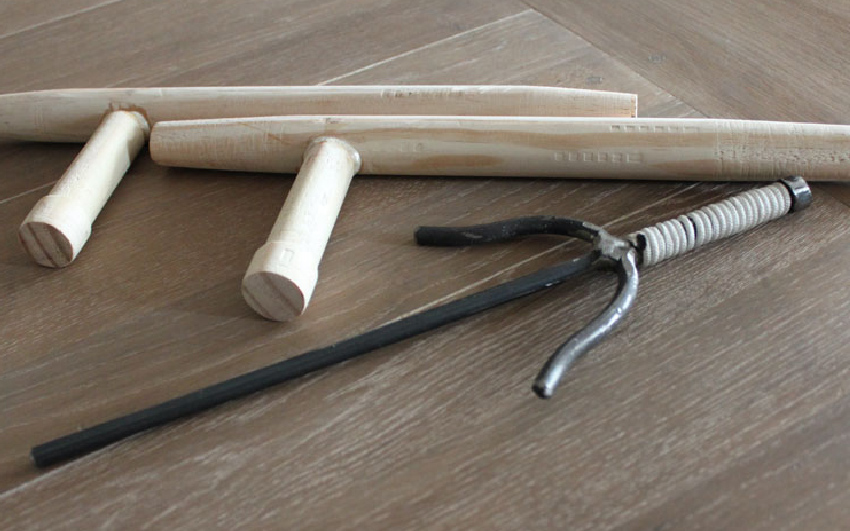Deadly (Sometimes Unusual) Karate Weapons
The Complete List of Okinawan Kobudo Weapons.
First of all, let me say that there are no such things as “Karate weapons”, there’s a bit of misconception here. As you know, Karate means “empty hand”, so it doesn’t teach the usage of weapons. However, there’s a martial art called Kobudo (meaning “ancient martial way”), the traditional weapon art of the Okinawan people, that is considered the sister art of Karate.
Kobudo was developed during the 17th century when the Samurai of the Satsuma clan had invaded Okinawa (called the Ryukyu Kingdom at the time) and established a ban on weapons and martial arts practice. The Okinawan people trained in secret and learned to use farmers and fishermen’s tools as weapons. Let’s learn more about those so-called “Karate weapons”.
List of Karate Weapons
Like Karate, the martial art of Kobudo (a.k.a Okinawan Kobudo), had a strong Chinese cultural influence and focuses on the study of weapons like the bo, sai, kama, tonfa, nunchaku, and tekko.
In Kobudo, the weapon is an extension of the body, and almost every Karate movement can be reproduced with a weapon in hand. I’ll begin this list from the most common to the least known weapons.
1. Tonfa
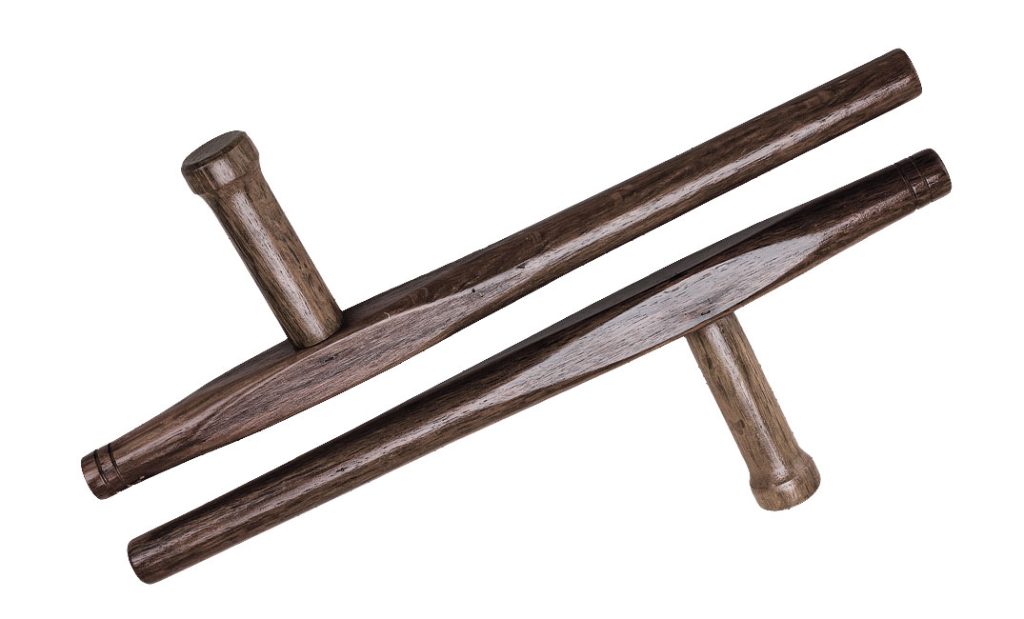
The tonfa is a wooden baton-like weapon used in Okinawan Kobudo. The length of the baton is about the length of the user’s forearm, and it’s attached to a handle that’s a little longer than the width of the user’s hand.
Origin: The origin of the tonfa is heavily debated, but most historians agree that it comes from Okinawa, where it was originally used as a millstone handle.
Usage: Two tonfa are often used simultaneously and can be utilized for both defense and offense. The Tonfa can be used to strike with circular rotating movements, to thrust, to block or parry weapons. In the hand of a proficient adapt, the tonfa can also be used to apply armlocks techniques and to control an opponent. Generally speaking, the forward part of the tonfa is used for blocking, and the ends for direct thrusting.
2. Sai
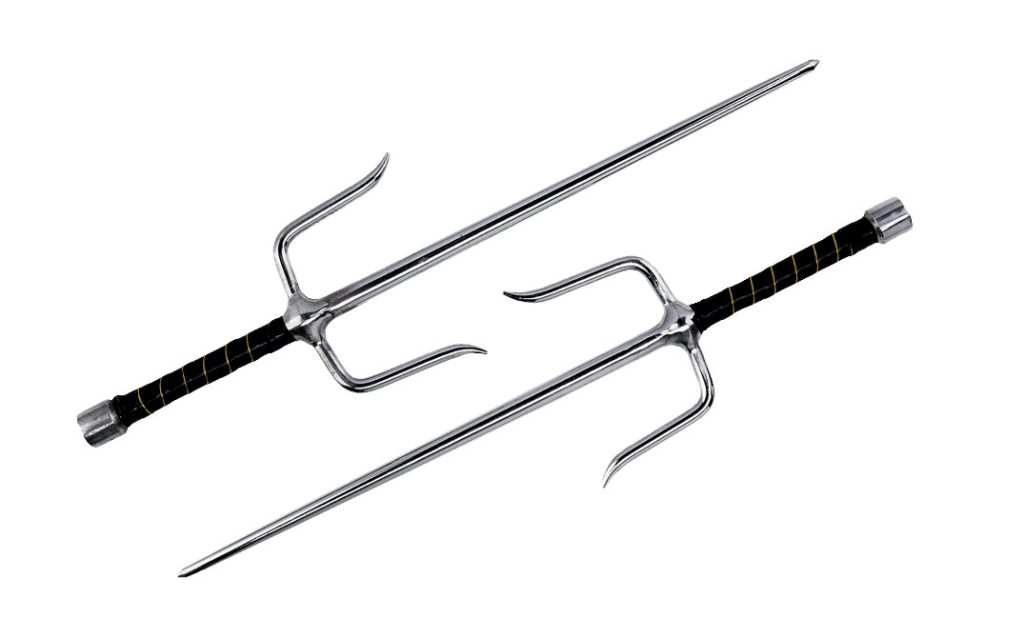
The sai is a pointed, rod-shaped baton, with two long, unsharpened prongs attached to the handle. Contrary to what most people believe, the shaft of a sai is not sharpened; it’s not a blade. Traditional Okinawan sai are round, while some modern version has an octagonal shape.
Origin: Some Japanese historians pretend that the sai was always intended as a weapon, while others state that it originated as an agricultural tool.
Usage: The sai is generally used in pairs, with one in each hand, and is used as a striking weapon, but it’s a very effective weapon for blocking other weapons. When handled by a skilled practitioner, the sai can be used to trap a katana blade between its branches and break it. Interestingly, most Karate kata can be adapted to be used with the sai.
3. Kama
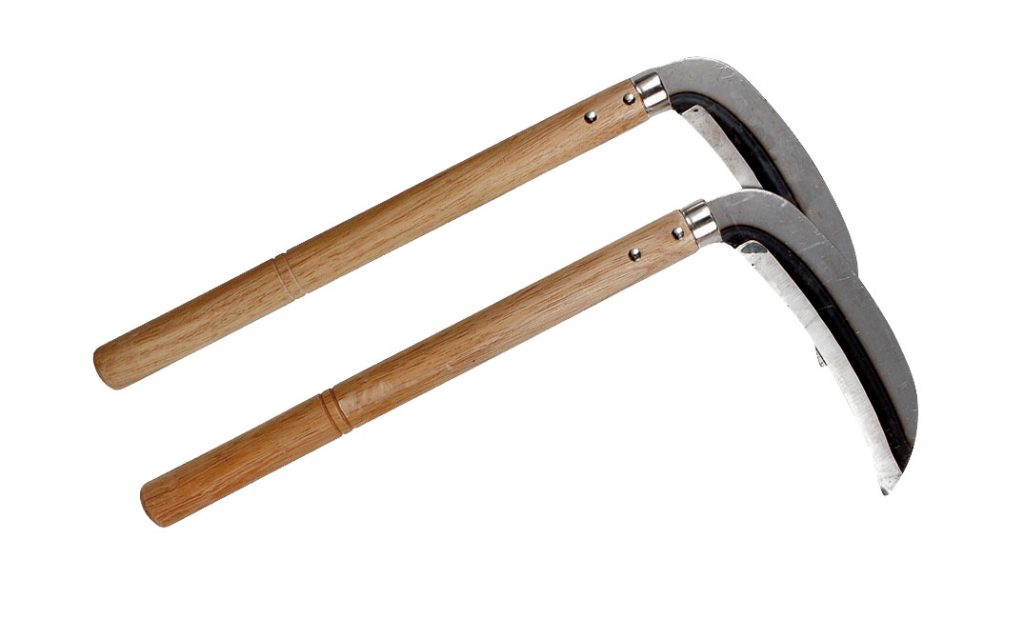
The Kama is a Japanese and Okinawan weapon that’s basically a stick with a razor-sharp blade attached perpendicularly to its end.
Origin: Before being used as a weapon, the kama was extensively used as sickle throughout Asia. The Kama was most probably imported from mainland Japan to Okinawa and started being used as a weapon during the Satsuma occupation.
Usage: The kama is a dangerous and versatile weapon that’s generally used in pairs, and that can be used to not only to slash, but also to block, trap, and disarm an opponent. The Kamas are often used to simultaneously block an attack with one kama and counterattack with the other. It’s also used to deliver double strikes.
4. Bo

The bo is a five to six feet long wooden staff commonly found in Chinese, Okinawan, and Japanese martial arts, but made famous by the legendary Shaolin Monks.
Origin: The earliest form of the bo staff has been used throughout Asia since the beginning of recorded history. In an effort to protect themselves during the Satsuma Invasion, the people of Okinawa started to carry around the bo, which was not officially considered a weapon.
Usage: The bo is usually made of oak and can be a devastating weapon in the hands of a specialist. It can be used to strike with circular movement or to thrust, and it’s also well suited for blocking and sweeping. Because of its Kung-Fu roots, the practice of the bo is often incorporated into the practice of Karate.
5. Jo
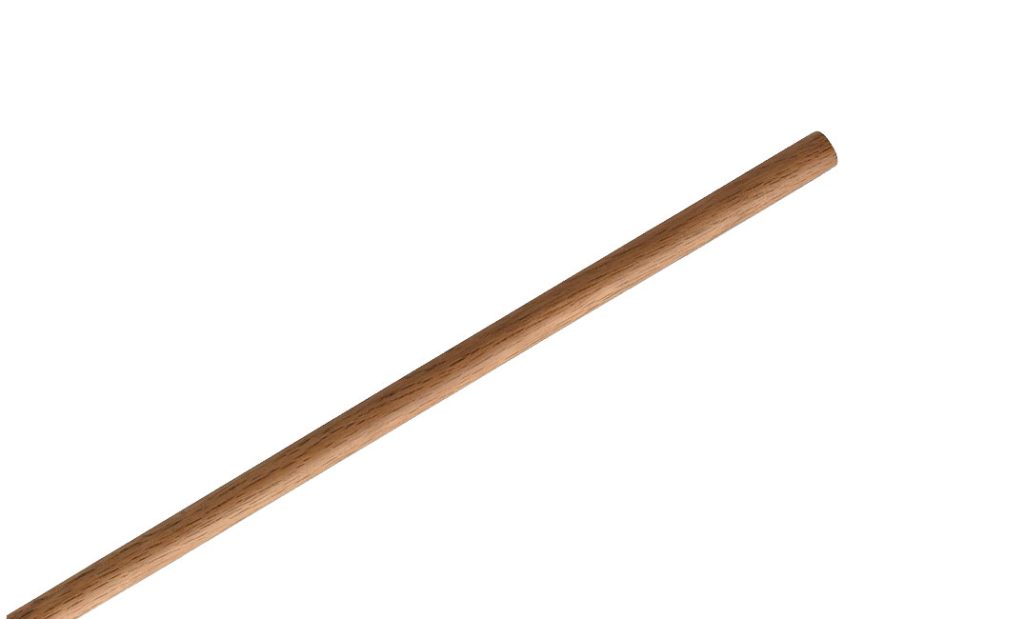
The Jo, a four-feet long wooden staff, is one of the ancient weapons of both Japan and Okinawa.
Origin: Historical evidence indicates that the staff was used as a weapon very early in the history of mankind by almost every human culture, but its practice has perfected in China, Okinawa, and Japan.
Usage: Like the bo, the jo is usually made of oak and can be lethal if used by a master. Because of its shorter length and faster speed, the jo is handled a bit differently from the bo. However, most strikes, thrusts, and blocks from bo techniques can be applied to the jo. Its usage is as a mix between the bo and the sword.
6. Nunchaku
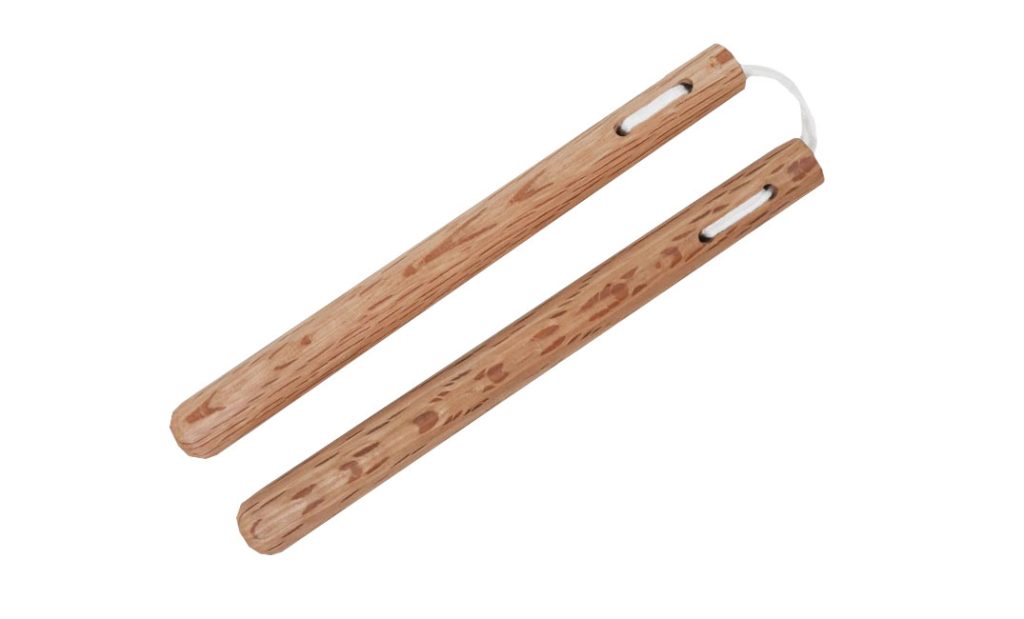
Made famous by Bruce Lee, the nunchaku is composed of two small batons connected by a cord or a chain and is an impressive weapon in the hand of a specialist.
Origin: Like many Kobudo weapons, the nunchaku was originally a farming tool used as a short flail throughout Asia to beat rice. It grew as a weapon under the Satsuma invasion due to their restrictive policy of weapons control.
Usage: The Nunchaku can be operated with tremendous speed for striking, but can also be worthy for parrying attacks from other weapons. The nunchaku is used to strike vital spots, and apply joint locks, chokes, and other control techniques. When used in combat, the nunchaku provides the advantage of an increased range. The nunchaku is one of my favorite “Karate weapon”.
7. Eku
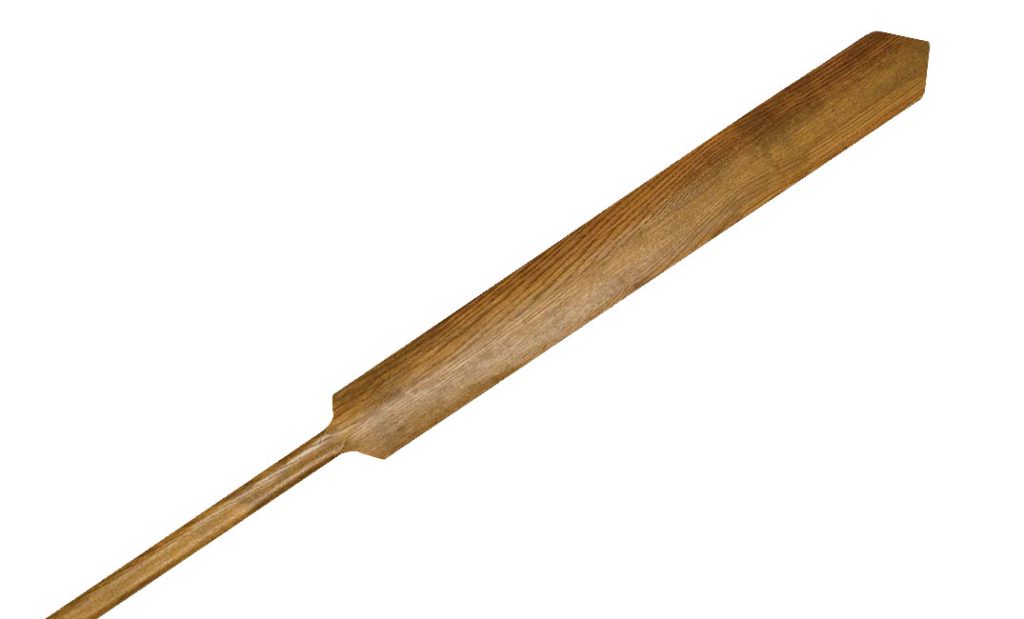
The Eku is a typical Okinawan martial arts weapon that originated from a boat oar.
Origin: Some historians believe that the Eku started being used as an improvised weapon by Kobudo practitioners during the Satsuma Invasion. Other historians claim that, because of their similar shape and lower price, boat oars started being used instead of more expensive Naginata (Japanese halberd).
Usage: The eku is used somewhat similarly to the bo, but because of it’s “blade”, it’s employed more circularly to strike. Because of its weight, eku techniques often capitalize on the momentum of its large circular attacks. The eku is heavy, and its displaced center of gravity and makes it more challenging to master than the bo.
8. Tekko
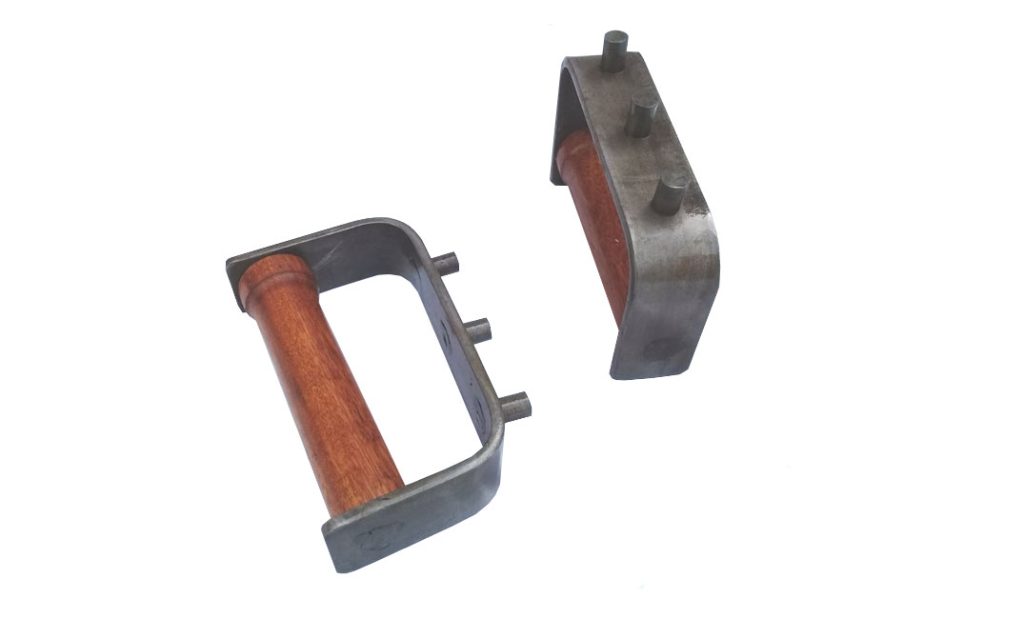
The Tekko is a traditional Okinawan martial arts weapon. It is a hand-held metal weapon similar to a modern knuckle buster or brass knuckles.
Origin: Originally made from horseshoes, the tekko were easy to carry and conceal, avoiding raising suspicion during the Japanese occupation of Okinawa. The tekko evolved from an earlier version of the suntetsu.
Usage: More than other Kobudo weapons, the Tekko was carried by ancient Karate practitioners for self-defense purposes against armed and armored Satsuma samurais. The techniques used with the Tekko consist mostly of traditional Karate punches and hand strikes. An already deadly Karate master using tekko becomes even more dangerous.
9. Tambo
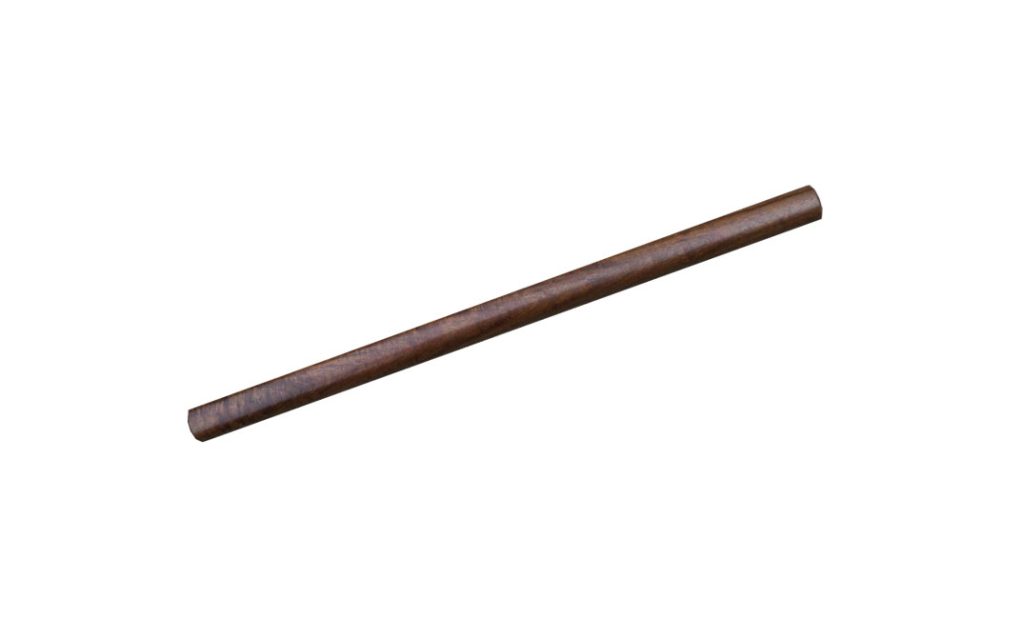
The tambo (also tanbo or tanjo) is a traditional short wooden staff of roughly 18 inches that was used as a self-defense weapon in Okinawa and feudal Japan.
Origin: The origin of the Tambo in unknown, but it’s pretty safe to assume that it’s derived from the staff.
Usage: The tambo is a less common Okinawan weapon. Because of its small size, it can be used with high speed and accuracy to hit various vital points of the human body. The tambo is mostly used to thrust, but it can also be used to apply pressure points or joint-locks techniques. By holding each end, it can be effective to block or parry an enemy’s punch, kick, or weapon. The tambo can be deadly in skilled hands.
10. Kuwa
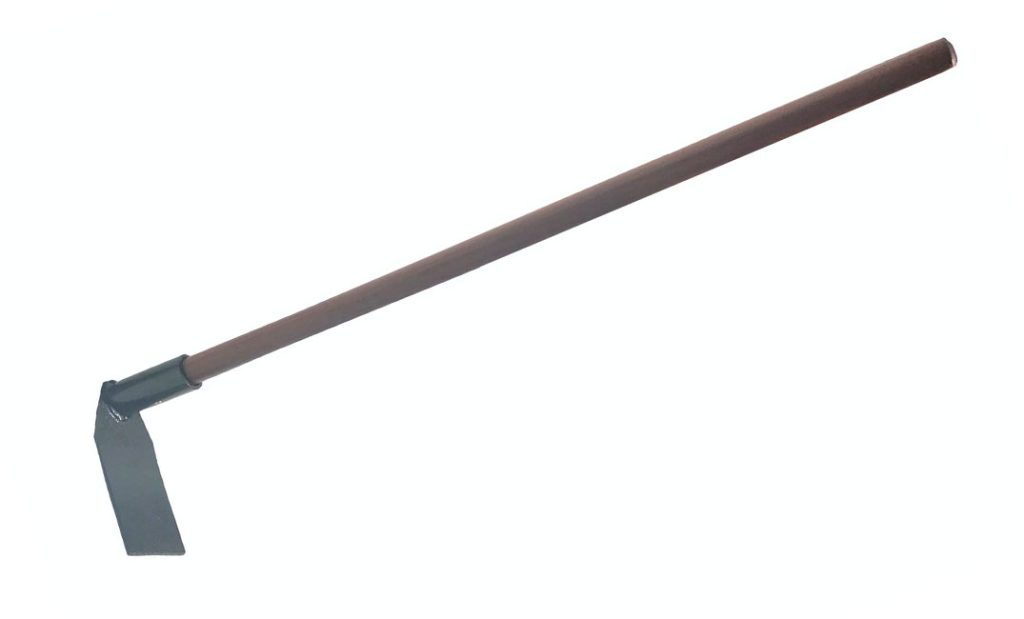
The Kuwa is an Okinawan weapon that’s actually a garden hoe. The blade of the kuwa is between 4″ to 6″ wide, and the handle’s length is about three feet.
Origin: Like many other Okinawan Kobudo tools, the kuwa started being used in Okinawa, when people were banned from using weapons – they started using common farming tools to defend themselves.
Usage: Because of its unique form, the kuwa can be used both as a striking and slashing/cutting weapon and as a defensive and tools. Although the kuwa is a simple farming tool, it developed into formidable weapons, especially in the hands of a master.
11. Nunti Bo
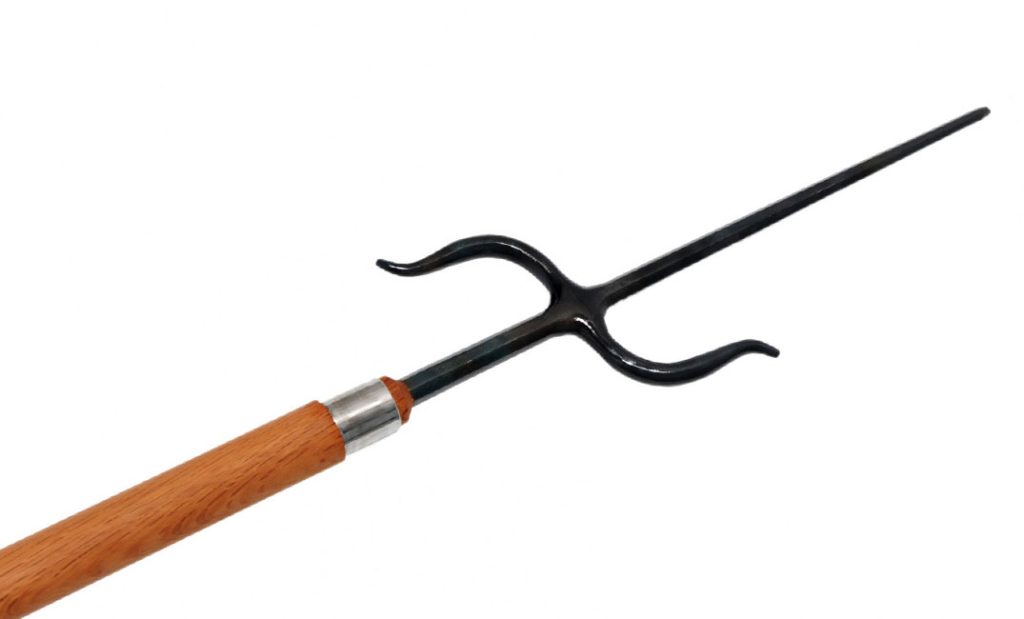
The nunti bo is a five to six feet long wooden spear equipped with a metal tip composed of two sharp hooks – one pointing up, the other pointing down.
Origin: Originally used as a tool by Okinawan fisherman, the nunti bo was actually a fishing spear used to stab or impale fish. The inward hook was used to pull nets in the boats and the outward hook to push boats off from the dock.
Usage: The nunti bo is a long-range weapon that can be used similarly to the bo, but with added functionalities. It is mainly used to stab, but also, because of the hooks, to catch and trap an opponent’s weapons or body parts. The nunti bo is also great for sweeping an enemy.
12. Kuruma Bo
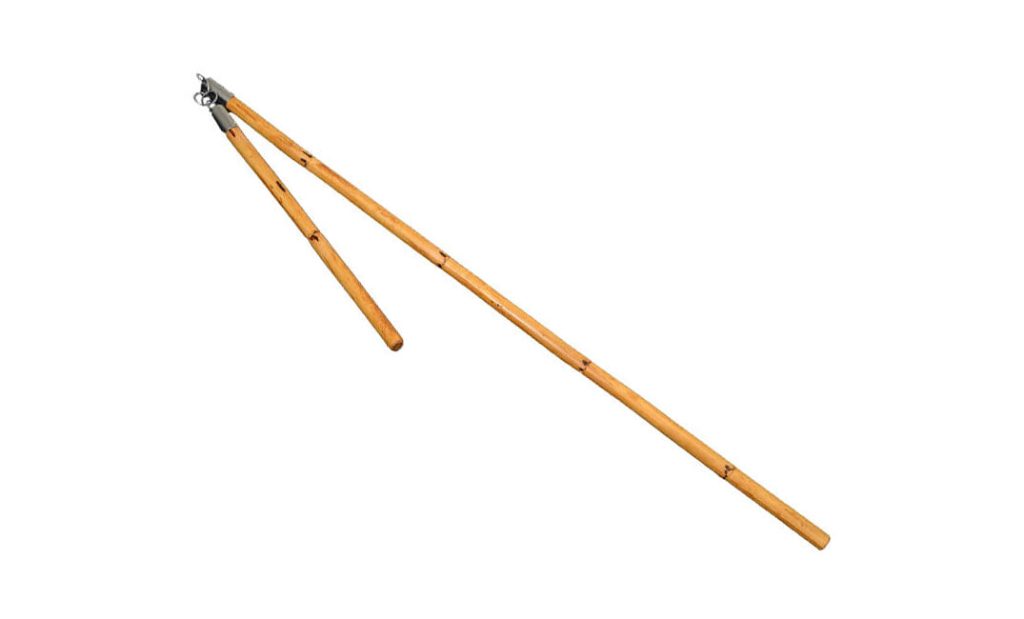
The Kuruma Bo is a type of Okinawan flail made up of two sticks united by a rope or chains. The longest stick serves as handle, and shortest and heavy is used to strike.
Origin: The Kuruma Bo was an Asian agricultural instrument used for threshing cereal. A similar tool as also found in ancient Europe.
Usage: The Kuruma Bo is both a defensive and offensive weapon that can, because if its simplicity, be learned rather quickly with devastating effect. The swinging part can be used very efficiently against multiple opponents. Its usage is similar to the nunchaku and the sansetsukon or three-section nunchaku.
13. Tinbe-rochin
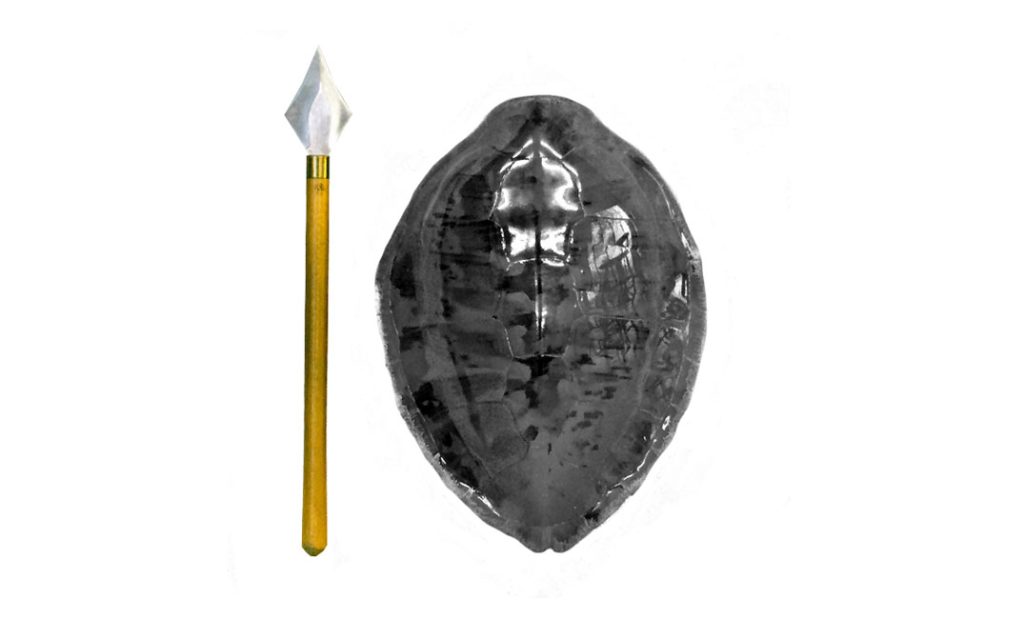
The tinbe-rochin is one of the unknown weapons of Okinawan Kobudo and consists of a shield and a short spear. The tinbe or shield was traditionally made from a turtle shell or in metal, and the timbe was spear roughly 18 inches long.
Origin: The use of the tinbe-rochin has been traced back to Okinawa at the beginning of the14th century, long before the Satsuma Invasion.
Usage: The shield is primarily used to block/defend against oncoming strikes. The short length of the spear makes it more manageable in one hand and is mainly used to thrust and slash but can also be used defensively as well. By examining the movements found in old tinbe-rochin kata, we can acknowledge that the spear was predominantly used to stab under the armor – lower belly, groin, armpits, and throat.
14. Surujin
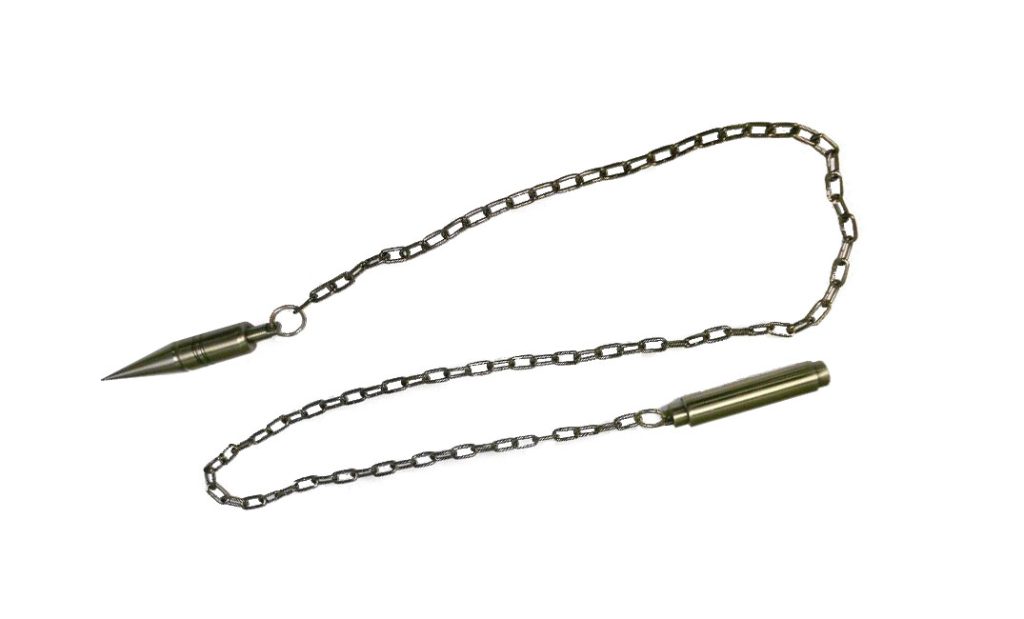
The surujin, also called suruchin, is one of Okinawa’s traditional weapons and is basically a two or three-meter long rope with a weight attached to each end. Originally, this weapon had stones attached to each end, but metal weights or metal points eventually replaced them.
Origin: The exact origin of the surujin is unknown, but some historians claim it derived from fishermen’s tools.
Usage: Techniques for the Surujin include strikes that are delivered by swinging the weapon or by throwing one of the weighted ends. The weight can also be used to catch a weapon or a leg, and the rope or chain can be pulled to unbalance the enemy or disarm him. It’s, as you can imagine, a weapon that demands great skills to master.
15. Sansetsukon
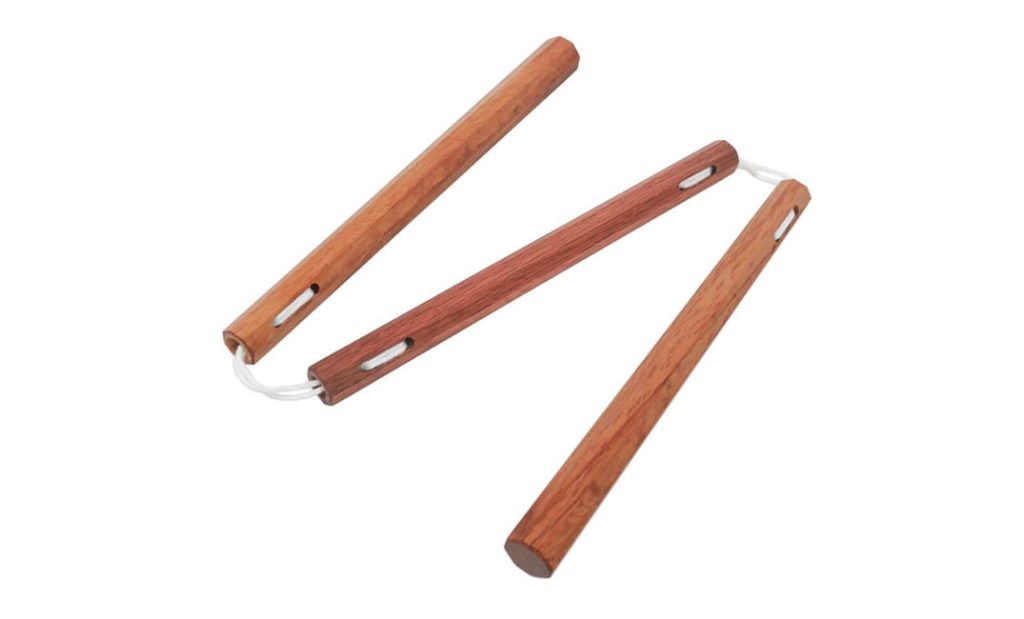
The sansetsukon is a three-section wooden Japanese flail, connected by metal rings or rope. Each wooden staff is about 24 inches in length.
Origin: The weapon originated from China and was apparently developed by Shaolin monks, who would put a rope between broken parts of staves to continue to use it.
Usage: The sansetsukon is a unique weapon, and it can be quite tricky to master. Used with both hands, it can be used to strike and block simultaneously, offsetting the opponent’s timing. It can also be used like a nunchaku or like a dual tambo. The sansetsukon is definitely a weapon that’s hard to predict for an opponent.
Conclusion
As you can see, there’s a great selection of “Karate weapons”, and most of them were either farming/fishing tools or of Chinese origin.
As a Karate practitioner, I think that it’s essential to learn (at least a little) to used Okinawan Kobudo weapons, not with the goal of mastering them, but as a complement to your Karate. The knowledge and understanding you’ll gain by manipulating weapons will make you a better Karate practitioner and will broaden your vision of your hand to hand practice.
What’s your favorite weapon?
- 10 Ways Meditation can Improve Your Karate - March 6, 2024
- Is Tai Chi Effective for Self-Defense? - February 16, 2024
- Do You Need to Add Ground Grappling Into Your Karate? - February 15, 2024

